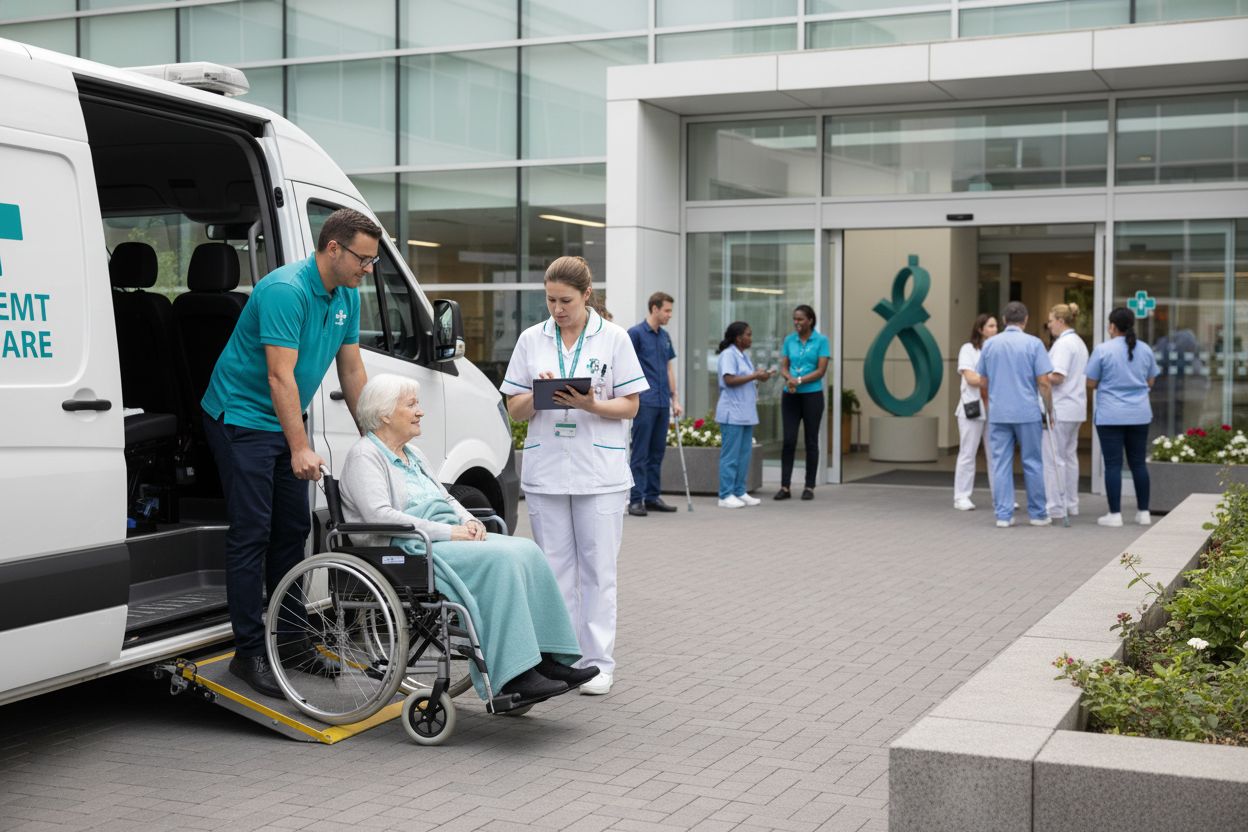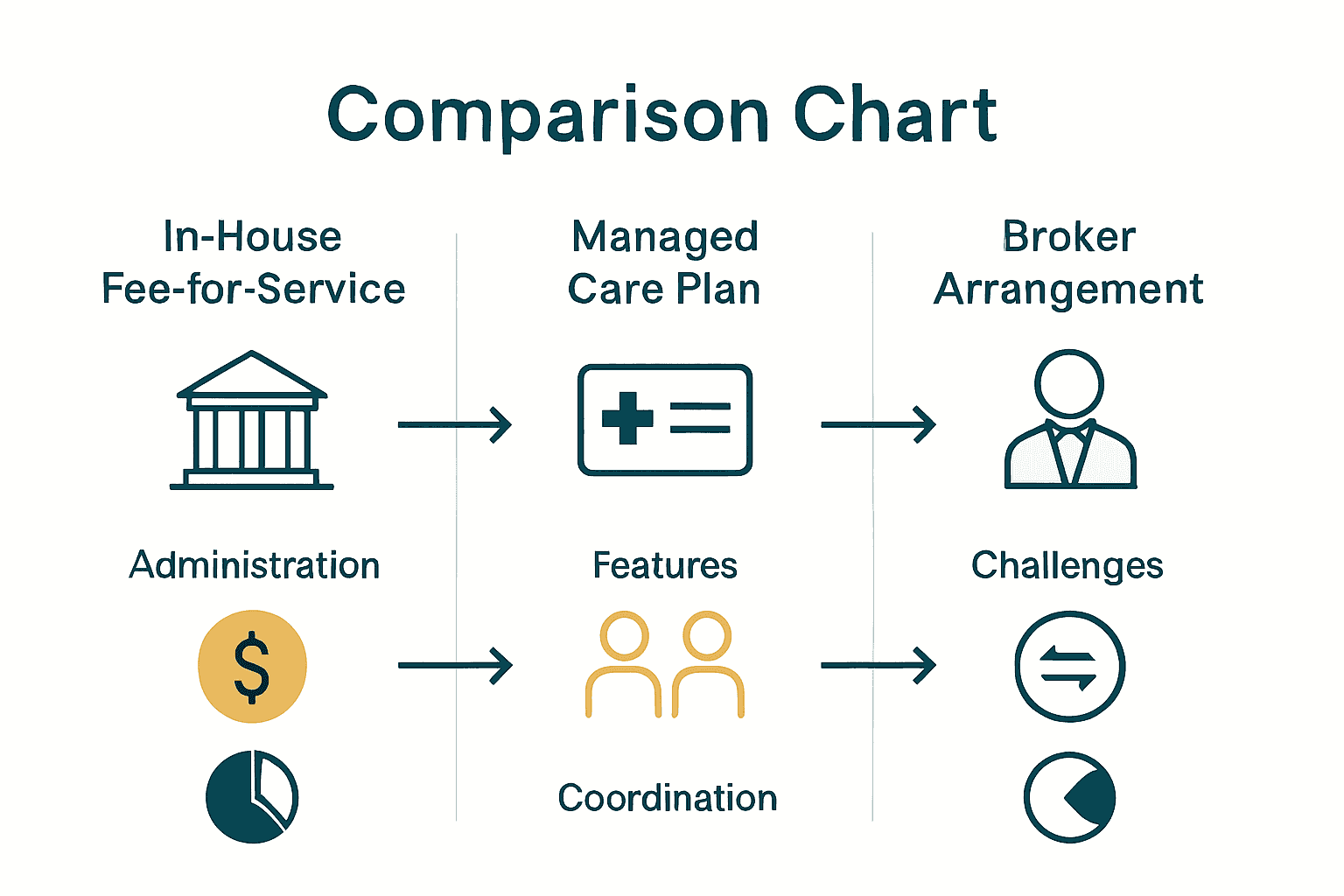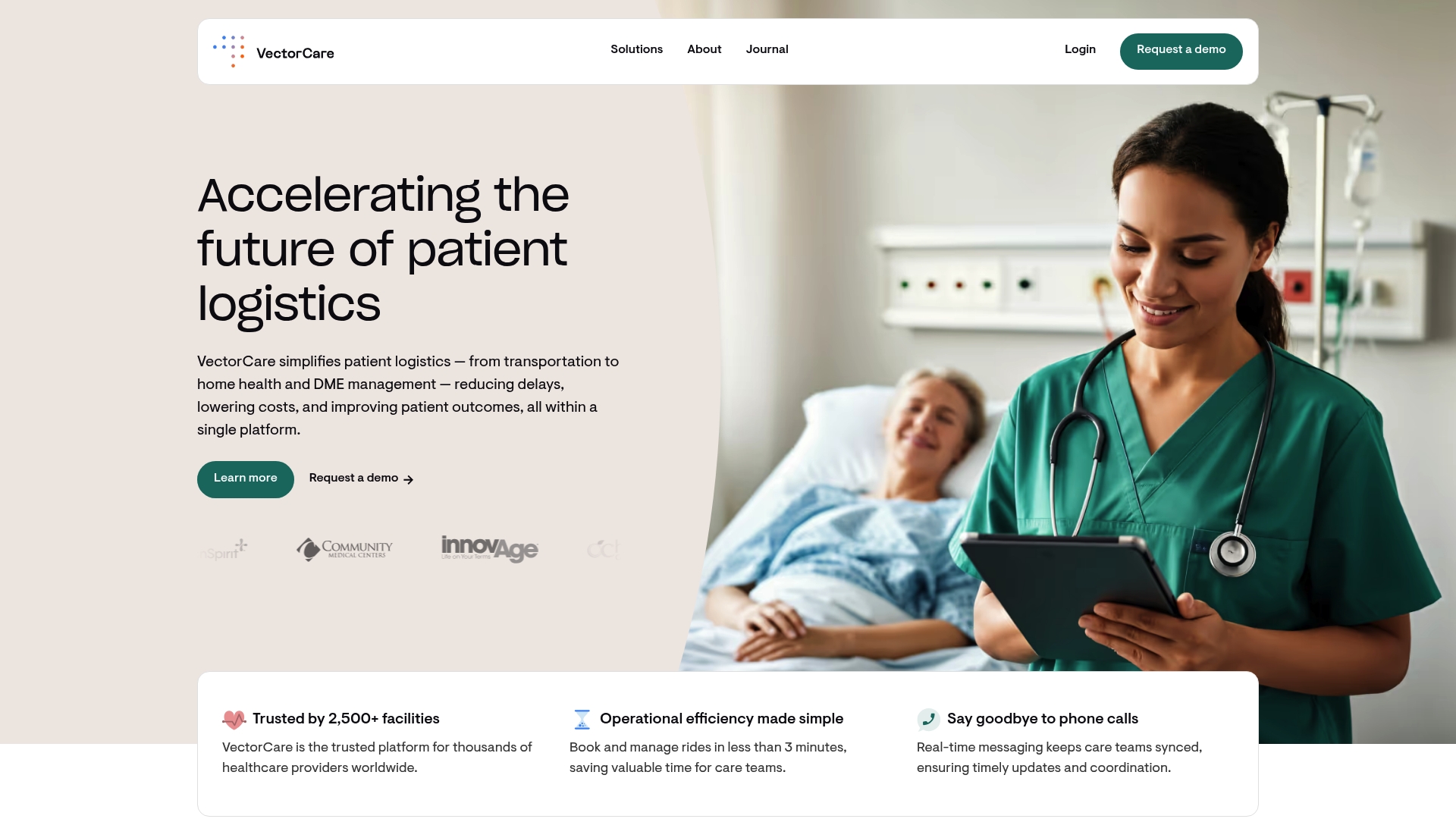Complete Guide to NEMT Medical Transportation

Missed medical appointments cost the US healthcare system over $150 billion each year. Many of these absences happen simply because patients have no way to get to their doctors. Reliable transportation means more than just convenience for millions who depend on regular medical visits. Understanding how specialized ride services work can help families, providers, and communities find better ways to support essential healthcare access.
Key Takeaways
| Point | Details |
|---|---|
| NEMT Importance | Non-Emergency Medical Transportation (NEMT) is vital for ensuring healthcare access for patients unable to transport themselves, thus improving health outcomes. |
| Service Models | NEMT operates through multiple administrative models, including in-house, managed care, and broker arrangements, each with distinct features and challenges. |
| Legal Framework | NEMT is governed by regulations that ensure patient safety, service quality, and program integrity, focusing on compliance with Medicaid guidelines. |
| Technological Advancement | Emerging technologies like AI and mobile applications are enhancing NEMT operations, improving scheduling efficiency, and patient experience. |
Table of Contents
- What NEMT Medical Transportation Means
- Types And Service Models Defined
- How NEMT Operations Function
- Legal Framework And Compliance Needs
- Key Technologies Enhancing NEMT
- Operational Challenges And Cost Considerations
What NEMT Medical Transportation Means
Non‑Emergency Medical Transportation (NEMT) is a specialized transportation service designed to help patients access critical healthcare services when they cannot drive or arrange transportation independently. NEMT bridges a crucial healthcare accessibility gap, ensuring patients can reliably reach medical appointments, diagnostic centers, and treatment facilities.
According to the Centers for Medicare & Medicaid Services, NEMT is a Medicaid-covered benefit in the United States that provides vital transportation assistance. The service covers a range of transport types and has specific criteria for drivers and vehicles. These transportation services support various healthcare destinations, including:
- Physician offices
- Diagnostic testing sites
- Dialysis centers
- Hospitals
- Physical therapy centers
- Mental health facilities
As research from the National Conference of State Legislatures indicates, transportation represents a fundamental factor in healthcare access. For Medicaid beneficiaries without reliable personal transportation, NEMT ensures they can consistently attend necessary medical appointments, ultimately supporting better health outcomes and preventive care.
The core purpose of NEMT extends beyond simple transportation – it’s about removing barriers to healthcare. By providing safe, reliable, and specialized transportation, these services help vulnerable populations maintain their health, manage chronic conditions, and access essential medical treatments that might otherwise be out of reach.
Types And Service Models Defined
Non-Emergency Medical Transportation (NEMT) services are structured through multiple administrative models, each designed to meet diverse healthcare transportation needs across different regions and population groups. Research from the National Conference of State Legislatures reveals that state Medicaid agencies predominantly utilize four primary service delivery approaches to manage these critical transportation services.
The primary NEMT service models include:
Here’s a comparison of the main NEMT service models:
| Service Model | Administration | Key Features | Potential Challenges |
|---|---|---|---|
| In-House Fee-for-Service | State Medicaid agencies | Direct control Fixed rates |
Less flexibility Higher costs |
| Managed Care Plan | Private insurers | Integrated with healthcare plans Flexible routing |
Complex coordination |
| Broker Arrangement | Third-party brokers | Central dispatch Cost-effective solutions |
May limit patient choice |
- In-House Fee-for-Service Model
- Direct management by state Medicaid agencies
- Government-controlled transportation infrastructure
- Fixed rates for transportation services
- Managed Care Plan Model
- Transportation services integrated with healthcare plans
- Private insurers manage transportation logistics
- Typically offers more flexible routing options
- Broker Arrangement Model
- Third-party organizations coordinate transportation
- Centralized dispatching and vendor management
- Potential for more cost-effective solutions
According to Kaiser Family Foundation research, the broker model—authorized by the Deficit Reduction Act—enables more cost-effective administration while potentially limiting beneficiary transportation choices. This approach allows states to optimize NEMT services through specialized intermediary organizations that can negotiate rates, manage vendor networks, and streamline transportation logistics.
Each service model offers unique advantages and challenges, with states selecting approaches that best match their specific healthcare infrastructure, budget constraints, and population needs.

The ultimate goal remains consistent: providing reliable, accessible transportation for patients who cannot independently reach medical appointments.
How NEMT Operations Function
Non-Emergency Medical Transportation (NEMT) operates through a complex, flexible system designed to meet diverse patient transportation needs. The Transportation Alliance highlights the multifaceted booking mechanisms that enable these critical services, which can be arranged through several coordination channels:
- Advance Booking: Scheduled transportation planned days or weeks ahead
- On-Demand Scheduling: Immediate transportation requests
- Coordination Methods:
- Direct broker interactions
- Case manager referrals
- Centralized phone booking systems
The operational vehicles for NEMT are equally diverse, accommodating various patient requirements:

- Standard taxis
- Wheelchair-accessible vans
- Public transit options
- Specialized medical transport vehicles
- Volunteer driver networks
- Mileage reimbursement programs
Research from the Kaiser Family Foundation reveals the extensive scope of NEMT services, which cover transportation for critical healthcare needs including:
- Behavioral health appointments
- Dialysis treatments
- Preventive care visits
- Specialist consultations
- Rehabilitation services
- Adult day health care programs
This comprehensive approach ensures that Medicaid beneficiaries with limited transportation options can consistently access essential medical services, regardless of their specific healthcare requirements or personal mobility challenges.
Legal Framework And Compliance Needs
Non-Emergency Medical Transportation (NEMT) operates within a complex legal framework that ensures patient safety, service quality, and program integrity. The Centers for Medicare & Medicaid Services (CMS) provides comprehensive guidelines that establish critical standards for NEMT operations, focusing on several key regulatory dimensions:
Key Regulatory Dimensions
- Distinguishing emergency from non-emergency transport
- Defining acceptable transportation vehicle types
- Establishing driver qualification standards
- Identifying and preventing potential fraud schemes
Compliance Requirements encompass multiple legal considerations. According to Kaiser Family Foundation research, the legal foundation for NEMT is primarily established through:
- Medicaid Law Provisions
- Classified as a medical service benefit
- Governed by Federal Medical Assistance Percentage (FMAP) regulations
- Enables brokerage program implementations
- Patient Rights Protection
- Guarantees beneficiary free choice of transportation providers
- Ensures non-discriminatory service delivery
- Maintains transparent reimbursement mechanisms
The Deficit Reduction Act plays a pivotal role in shaping NEMT’s legal landscape, providing states flexibility in designing transportation programs while maintaining strict oversight. This legislative approach balances operational efficiency with robust compliance standards, ultimately protecting both patients and healthcare systems from potential misuse or inefficient resource allocation.
Key Technologies Enhancing NEMT
Digital transformation is revolutionizing Non-Emergency Medical Transportation, introducing sophisticated technologies that dramatically improve service efficiency and patient experience. According to NEMT Entrepreneur, emerging technologies are creating unprecedented operational capabilities across the transportation ecosystem.
Core Technological Innovations
Artificial Intelligence and Optimization Technologies:
- AI-driven route planning
- Predictive scheduling algorithms
- Reduced travel times and fuel consumption
- Minimized patient no-show rates
Tracking and Communication Technologies:
- Real-time GPS vehicle tracking
- Mobile scheduling applications
- Automated dispatch systems
- Integrated communication platforms
HM Transport research reveals that technological innovations are transforming key operational aspects, particularly through:
- Enhanced Booking Experiences
- Simplified mobile scheduling
- User-friendly interface design
- Instant confirmation mechanisms
- Healthcare System Integration
- Electronic Health Record (EHR) interfaces
- Seamless telehealth coordination
- Data analytics and reporting
Additionally, sustainability technologies are emerging as critical components, with electric vehicles and automated compliance tools reducing environmental impact while streamlining administrative processes. You can explore more about the future of NEMT digital transformation and its potential to revolutionize patient transportation services.
Operational Challenges And Cost Considerations
Non-Emergency Medical Transportation (NEMT) faces increasingly complex operational challenges as healthcare demographics shift. The Transportation Alliance highlights that rising chronic disease prevalence and aging populations are creating unprecedented demand and financial pressures on transportation providers.
Funding and Cost Management
Funding sources for NEMT programs typically include:
- Medicaid reimbursements
- State and local government programs
- Hospital system allocations
- Grant-based funding mechanisms
Cost Control Strategies are critical in maintaining sustainable NEMT services. Kaiser Family Foundation research indicates that brokerage models have emerged as an effective approach to:
- Deter potential fraud
- Control overall program spending
- Optimize resource allocation
- Maintain service quality
Operational inefficiencies carry significant financial consequences. Missed medical appointments due to transportation issues result in:
- Wasted healthcare resources
- Increased long-term treatment costs
- Poorer patient health outcomes
Learn more about reducing operational costs in healthcare organizations, where strategic approaches can transform transportation logistics from a cost center to a value-generating service. Implementing robust tracking, predictive analytics, and efficient routing can substantially mitigate financial challenges while improving patient access to critical medical services.
Take Control of Patient Transportation with Seamless Digital Workflows
Struggling to keep up with the complexities of Non-Emergency Medical Transportation? If your organization is dealing with missed appointments, rising costs, or administrative headaches from outdated systems, you are not alone. The article highlighted the real-world challenges of managing NEMT—especially issues like unreliable bookings, lack of real-time updates, and the constant pressure to improve compliance and efficiency. Many healthcare providers and payers want to close these gaps but find traditional approaches slow and burdensome.

Now is the time to modernize your approach. VectorCare’s digital platform empowers you to automate patient transportation logistics, optimize scheduling, and monitor each trip with real-time data. Our integrated tools help you reduce costly delays and ensure every trip meets rigorous legal and quality standards. Ready to simplify your NEMT operations and improve patient outcomes? Discover how VectorCare can help your team save time, gain full visibility, and deliver better care—visit our main site now and start transforming your patient logistics today.
Frequently Asked Questions
What is Non-Emergency Medical Transportation (NEMT)?
Non-Emergency Medical Transportation (NEMT) is a specialized service that helps patients reach healthcare appointments when they are unable to drive or arrange their own transportation. It is particularly important for individuals covered by Medicaid, ensuring they can access necessary medical care.
What are the different service models for NEMT?
NEMT services are typically structured through three main models: In-House Fee-for-Service, Managed Care Plan, and Broker Arrangement. Each model has unique features, challenges, and administration approaches that affect how transportation is provided to patients.
How do NEMT operations work?
NEMT operations can be arranged through various coordination methods, including advance booking, on-demand scheduling, and referrals from case managers. Different types of vehicles, such as standard taxis or wheelchair-accessible vans, are used to meet the needs of patients.
What compliance requirements must NEMT services meet?
NEMT services must adhere to several compliance requirements, including patient rights protection, driver qualification standards, and regulations outlined by the Centers for Medicare & Medicaid Services (CMS). These requirements help ensure the safety, quality, and integrity of NEMT operations.



